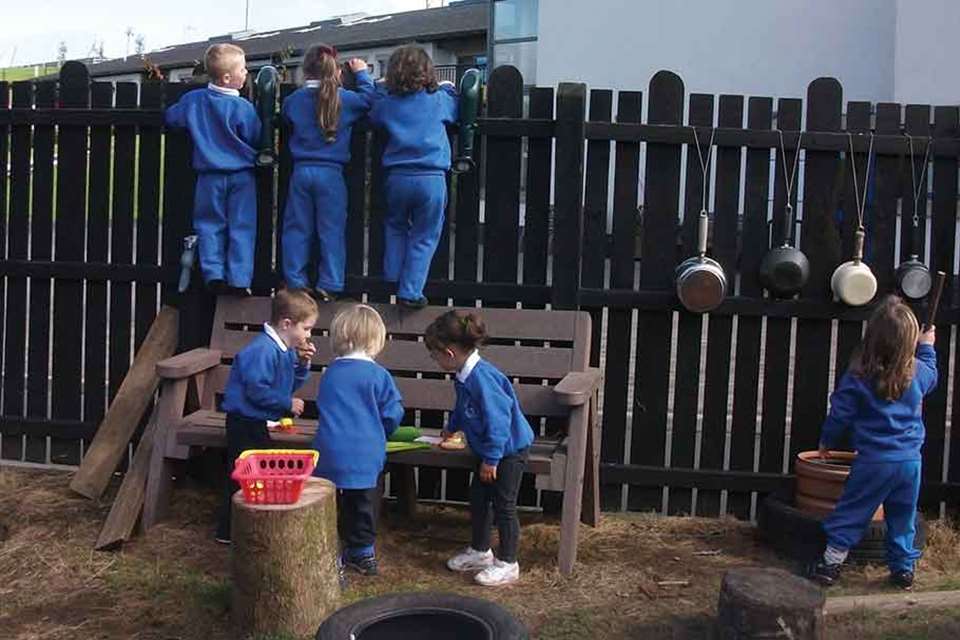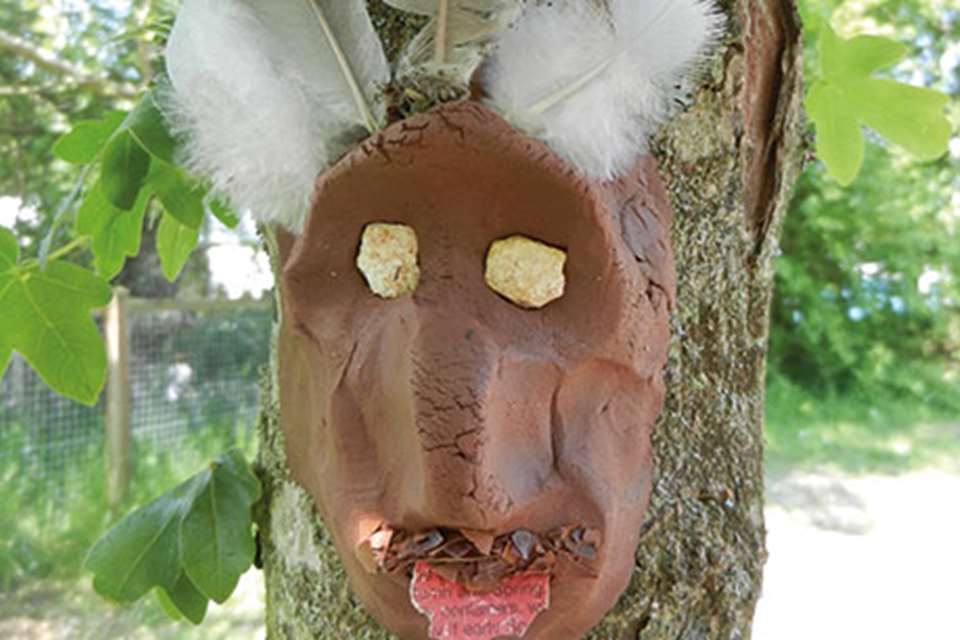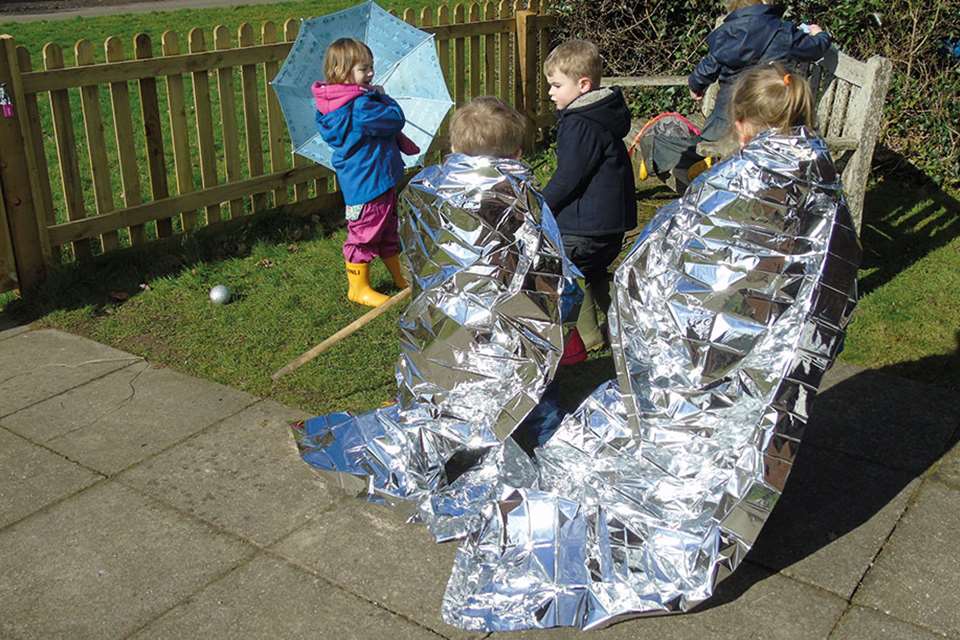EYFS Activities - Five things to do with… crates
Julie Mountain
Monday, July 24, 2017
Provide plenty of crates and they can be used in a variety of creative ways. By Julie Mountain

Plastic crates are ubiquitous in early years settings. However, the key to ambitious, adventurous crate play is abundance, and this is a regular refrain of mine – be generous with resources; the more you have, the fewer the conflicts and the greater the potential for creative play.
Crates are now readily available from outdoor play resource suppliers, though there is still something to be said for the joy of ‘acquiring’ crates from generous shops and businesses. Crates don’t all have to interlock or match, but it is important to have at least half a dozen of any set that does interlock if children are to use them for construction.
1. CRATE GARDENS
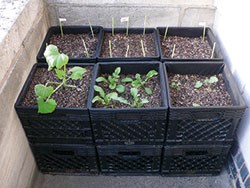 Limited for space? Short on greenery? After a portable kitchen garden? Repurpose old crates as raised planters by lining them with garden textile (sometimes known as Terram) and filling with soil and compost. The crate gardens will need to be watered regularly (like any raised bed) but are the perfect height and size for children to take ownership of. Herbs and root vegetables are fast-growing choices: consider sage, mint, lavender, strawberries, potatoes and carrots. Crates stacked one above the other can offer impressive displays of tumbling plants or flowers, and you could even line a crate and use it as a mini compost bin.
Limited for space? Short on greenery? After a portable kitchen garden? Repurpose old crates as raised planters by lining them with garden textile (sometimes known as Terram) and filling with soil and compost. The crate gardens will need to be watered regularly (like any raised bed) but are the perfect height and size for children to take ownership of. Herbs and root vegetables are fast-growing choices: consider sage, mint, lavender, strawberries, potatoes and carrots. Crates stacked one above the other can offer impressive displays of tumbling plants or flowers, and you could even line a crate and use it as a mini compost bin.
2. CRATE CONSTRUCTIONS
Crates form the foundation of any construction area, allowing children to quickly make an impact on a space. An abundance of crates of different kinds can widen the potential for imaginative crate play; combine them with other materials (sparkly fabric, blankets, tyres, pulleys) and connectors such as bungee cords, rope and pegs to allow larger groups of children to collaborate.
The photo above shows children creating a ‘volcano’. Over the course of the day, a great deal was learned about the inherent instability of volcanos and crates!
3. CRATES COUNT
Crates offer endless and intriguing maths opportunities: counting; sorting by size or colour; grouping by height/weight; weaving using the gaps; estimating volumes (‘how many tennis balls will fit in here?’); making slopes and bridges to test the speed of small-world vehicles; using two identical crates as the ‘dishes’ for a large-scale outdoor balance; target practice (green balls in the green crates, yellow bean bags in the yellow crates). Crates also make excellent mud labs, with plenty of storage space for pots, pans, stirrers and other equipment.
4. CRATE BOATS
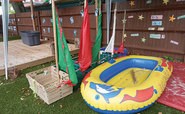 This captivating idea was spotted at a Childbase Nursery in Hampshire – there were several different types of ‘boats’ in the garden, but I loved this flotilla of simple yet compelling bread crate boats. The broom handle ‘masts’ were securely fastened to the crates with long cable ties and holes drilled into the top and bottom of each mast allow the sails to be easily attached. An inflatable dinghy added to the nautical theme and the whole set-up was a simple and quick way to provide role play in even the smallest space.
This captivating idea was spotted at a Childbase Nursery in Hampshire – there were several different types of ‘boats’ in the garden, but I loved this flotilla of simple yet compelling bread crate boats. The broom handle ‘masts’ were securely fastened to the crates with long cable ties and holes drilled into the top and bottom of each mast allow the sails to be easily attached. An inflatable dinghy added to the nautical theme and the whole set-up was a simple and quick way to provide role play in even the smallest space.
5. STORAGE SEAT CRATES
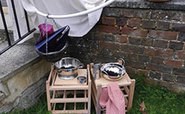 If you’re a keen crafter, it’s not difficult to make padded seat covers for crates, which will then do double duty as outdoor storage containers – perfect for independently accessible collections of balls, pine cones, mud kitchen equipment or even bottles:
If you’re a keen crafter, it’s not difficult to make padded seat covers for crates, which will then do double duty as outdoor storage containers – perfect for independently accessible collections of balls, pine cones, mud kitchen equipment or even bottles:
Cut a piece of marine plywood to fit loosely over the top of the crate, resting on its inner ‘lip’; cut a similarly sized piece of thick foam.
Your chosen heavy-duty fabric should wrap completely and snugly over the top of the foam and can be permanently attached to the plywood base with staples. If you run a hem along the perimeter of the fabric, and pass a length of elastic or string through the hem, you can pull it taut under the ‘seat’ and remove the cover for cleaning when necessary. Alternatively, choose a wipe-clean coated fabric.
BENEFIT-RISK ASSESSMENT
Transporting crates is great for children’s physicality, building strength, co-ordination and stamina. Imaginative crate play stimulates children’s creative impulses, and crazy constructions offer risk, challenge and a frisson of danger. However…
Whether your crates have been donated or bought, check them: look for cracks, sharp edges and finger traps; dispose of any unsuitable crates. It’s inevitable that crates will be dropped on toes, or tumbled over, but nips and cuts are best avoided.
Taller, wider or more ambitious crate structures may require connectors to avoid frustrating or hazardous collapses. Pegs, string, rope and duct tape encourage children’s independent experimentation; support children to use bungee cords (to avoid pinging elastic) and cable ties (to avoid trapped fingers).


